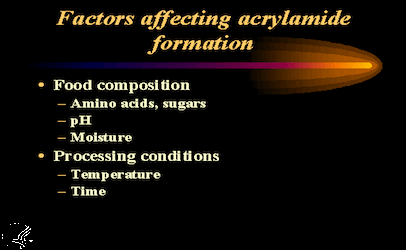The European Union and the United States are taking different approaches to a fairly recently discovered chemical that’s been in food as long as men and women have been cooking with fire.

By 2018, Europe will likely be enforcing mandatory limits on acrylamide in food. In 2016 the U.S. Food and Drug Administration came out with non-binding guidance “to help growers, manufacturers and food service operators reduce acrylamide levels in certain foods.”
At issue is what do about acrylamide in food. No one knew the chemical existed until it was discovered in 2002. It’s been around close to forever, though. The problem, according to the FDA, is that acrylamide can cause cancer in laboratory animals at high doses, and is “reasonably anticipated to be a human carcinogen.”
The European Food Safety Authority (EFSA) classified acrylamide as a carcinogen in 2015 and found levels had not “consistently decreased” in recent years. Voluntary measures to reduce acrylamide levels varied widely in European countries.
Then EFSA successfully petitioned the European Commission to impose mandatory measures on food business operators to reduce acrylamide levels in their products. The proposal still must get through the Council and European Parliament. The Council represents the ministers of Member States and the Parliament represents the European people.
Each unit gets three months to review the proposal, which makes enforcement likely by spring 2018.
Lithuanian Vytenis Andriukaitis, the EU’s commissioner for health and food safety, said the new regulation “will not only help to reduce the presence of this carcinogenic substance, but also will help raise awareness on how to avoid the exposure to it that oftentimes comes from home-cooking.”
The EU plans to set maximum allowable levels of acrylamide in certain foods once the regulation takes effect.
 Acrylamide forms from a naturally present amino acid called free asparagine when it interacts with sugars in foods during high-temperature processing, such as dying, roasting and baking. It is naturally present in starchy foods when roasted, baked or fried at high temperatures.
Acrylamide forms from a naturally present amino acid called free asparagine when it interacts with sugars in foods during high-temperature processing, such as dying, roasting and baking. It is naturally present in starchy foods when roasted, baked or fried at high temperatures.
Manufacturers of bread, breakfast cereals, biscuits, fried potatoes and coffee will be among those most effected by the pending EU regulation. Benchmark levels are being used to measure the effectiveness of mitigation measures the industry may use. The levels will be legally binding at the outset.
At the same time, so-called Belgian fries are exempted from the EU regulation, allowing the deep-fired potato treat to continue to be made in its traditional manner, which dates back to 1680. Belgian fries are twice fried, which makes them crunchier.
European consumer groups favored legally-binding limits. Other factions, like the German Baker’s Confederation and the Large Bakeries of Belgium, expressed worries about how breads were going to be categorized.
The Swedish Food Federation said it is “practically impossible to control acrylamide content in each individual package of food” because of the variability of acrylamide levels that will always occur. Others are worried about where strict enforcement will end up and the fact that the published benchmarks are described by some as being “impracticably low.”
In “Guidance for Industry: Acrylamide in Foods,” published in 2016, FDA said that “reducing acrylamide levels in foods may mitigate potential human health risks from exposure to acrylamide.”
“This guidance is intended to suggest a range of possible approaches to reducing acrylamide levels and not to identify specific recommended approaches. This guidance also does not identify any specific maximum recommended level or action level for acrylamide.”
The FDA gets very specific in its “non-binding” recommendations, including how to prepare french fries that come in frozen packages. It says both consumers and food service operators need to understand what they can do to help reduce acrylamide by following proper cooking instructions.

With frozen fries:
- Cook to a light golden color. Avoid browning fries.
- Avoid overcooking or undercooking.
- Avoid cooking in a toaster oven to prevent overcooking.
- Reduce cooking time when cooking small amounts.
Reduced acrylamide levels are achieved with that light golden color, from fries to toast.
The FDA reported it would update the guidance as needed to reflect new developments in the field of acrylamide reduction as they occur.
(To sign up for a free subscription to Food Safety News, click here.)
